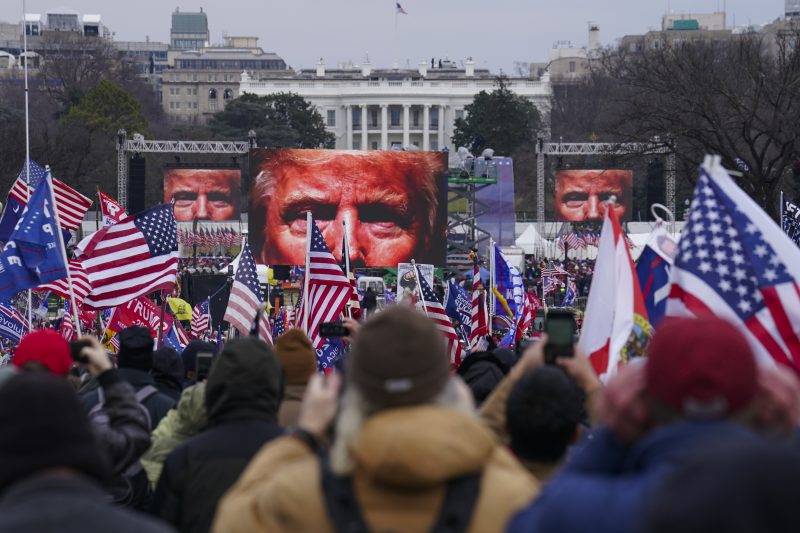Secretary Hegseth says the DOD does not do ‘climate change crap’
Google location data was used to find Jan. 6 rioters. It’s disappearing.


Special counsel Jack Smith has a plan for how to illustrate Donald Trump’s influence over the rioters who stormed the U.S. Capitol on Jan. 6, 2021. Prosecutors will show a map of people gathered around the Ellipse to hear Trump say, “we’re going to the Capitol” to “fight like hell,” then follow those supporters in real time as they head down Pennsylvania Avenue to where lawmakers were certifying President Biden’s victory.
That visualization, detailed in court filings in Trump’s federal election subversion case in D.C., was created with data from Google. But the tool that has pitted law enforcement investigative priorities against personal privacy concerns soon won’t be so accessible. The company will no longer store location history that was used to identify hundreds of people who stormed the Capitol on Jan. 6 and to prosecute the man those rioters hoped to keep in power.
Since 2016, law enforcement has used geofence warrants to pull information from smartphone owners who use “Google location history,” which regularly records a person’s location through a combination of cell tower, internet protocol, wireless, GPS and Bluetooth data. Police can also approximate locations through pings to cell towers. But the Google data is far more precise — making it possible in many cases, for instance, to discern whether someone was in the Capitol or right outside it.
The use of the data is still under debate. The chief judge in D.C. has yet to rule on a challenge to the geofence warrant from Israel Easterday, an Amish teen from Kentucky who helped rioters breach the Capitol Rotunda by pepper spraying a police officer. The neighboring U.S. Court of Appeals for the Fourth Circuit, which covers Virginia, Maryland and other neighboring states, is weighing whether this kind of warrant is constitutional, with stark disagreement over whether the data collection was voluntary sharing, fascist overreach or something in between.
“In the physical world, we have the scope of what’s allowed in a warrant,” said Orin Kerr, a professor at Berkeley Law who has tracked the legal debate over geofence warrants. “But we don’t have a sense in the open world” of online data.
A Google representative said the change was part of an ongoing effort to give people more control over their data.
Richard Salgado, Google’s Director of Law Enforcement & Information Security for 13 years and a former Justice Department attorney, said that the warrants were seen initially as potentially useful in “exceptional” situations but quickly “evolved into this routine strategy” investigators used even when other techniques were more likely to be effective.
“In the vast majority of cases this turns out not to be a useful technique,” he said. And he said these warrants can “evade oversight” since the government can just withdraw a warrant if the provider objects, thus avoiding a court ruling. Gag rules mean that users will never know their data was searched or exposed. “There is some discomfort that judges don’t really understand the limited value of the searches at the outset, and challenges don’t reach them.”
On Jan. 6 three years ago, the Justice Department sent a letter to Google directing it to preserve a copy of its data as it existed that day. Then two search warrants were sent to the company asking for a list for all devices Google registered in “Location History” as in or around the Capitol that afternoon. The government threw out phones shown as in the building before 12:50 p.m. or after 6:10 p.m., assuming those represented people working inside the Capitol. They also threw out any phone where the margin of error could place the user outside the grounds — unless that person had deleted their location history after the 6th, which the FBI took as a sign of culpability.
After that culling, the Justice Department obtained a court order for Google to “unmask” or name 9,341 users.
Judge James E. Boasberg said at an October hearing in Easterday’s case that he would probably side with the government. But he wanted more information about why so few Capitol staff were identified even though many were in the building: “The numbers need to make more sense.”
The government was following procedures developed by Google after consultation with the Justice Department, according to court records. The company would produce a list of the devices in the area and time requested. If asked, Google would provide more travel history for a smaller group deemed of interest to the government. With a court order, the company would then unmask the users of devices chosen from that list.
Geofence warrants became popular very quickly for law enforcement in the past 8 years because they could possibly pinpoint someone at or near the scene of a crime. In the first half of 2023, Google said it received more than 63,000 requests for disclosure of user information in the United States, covering 110,000 accounts, and handed over at least some data 85 percent of the time. The company did not break out location-data requests specifically, but Google said in 2021 that geofence warrants constituted more than a quarter of all warrants they received in the U.S.
The Jan. 6 case — the largest investigation in U.S. history that has to date netted more than 1,200 people charged — is unusual in that the government could plausibly argue everyone within the geofence had committed or witnessed a crime. “Those are really the exceptions that prove the rule,” said Brett Max Kaufman of the ACLU, which is involved in the Fourth Circuit challenge related to a Virginia robbery. But Jennifer Lynch of the Electronic Frontier Foundation argues that the Capitol warrants are as bad as other geofences.
“The January 6 example is a really tough one,” she said. “But it’s still not targeted. The whole reason we don’t have mass warrants is that then we have to trust the government to make the right decisions.”
Turning on location history is optional; as of 2019 Google said a third of users had the feature enabled. A user can also edit the “timeline” of past trips Google creates from the data. To respond to a geofence warrant, Google has to search data from every device using location history — approximately 592 million people. Now, Google says the data will only be stored for three months and only on the device itself, making it impossible to access remotely by law enforcement. That aligns Google with Apple, which does not store location data in a way that is open to a geofence warrant.
While the warrants might be disappearing, legal battles over their constitutionality will keep going for years. Experts disagree about whether data aggregation companies — also served warrants in Jan. 6 cases — could successfully replicate Google’s data.
“For now I think that does sort of end the practice,” Kaufman said, but “there are other types of databases where the same legal arguments could apply.”
The question is whether such warrants are unreasonable searches invading the privacy of people who just happen to be near the scene of a crime. In the Fourth Circuit case, people in nearby buildings, including a church, were within the parameters of the search for a bank robber in Richmond. “Police cannot act like the prince in Cinderella, knocking on local doors to order occupants to try on a slipper left at the ball,” Alexandria federal defender Geremy Kamens wrote in Easterday’s case.
Google itself described the searches in court as “broad and intrusive” and said that “users have a reasonable expectation of privacy” in their location history, which is akin to “a virtual journal.” Location history can remind you where you’ve been before and how long it took you to get there, and recommend stops and real-time traffic information on your regular commutes. It’s also used for advertising — businesses can show ads to everyone in a particular location, and Google can say how many people visited a store after seeing an ad.
The location data varies in accuracy depending on whether and how the phone is being used, along with the strength of various signals.
The government has emphasized the voluntary, opt-in nature of the product and says no federal court has thrown out evidence obtained through a geofence warrant. (A state court in California has). In the Richmond case, a district court judge ruled that the warrant used to identify the bank robber was far too broad, but that the officers who used it were acting in “good faith.” She also said the Jan. 6 warrants were different in “crucial” ways, including more judicial oversight.
Her decision was argued over at the Fourth Circuit last month. Judge Julius Richardson suggested there was no need for geofence warrants, because “if I didn’t opt into the service … it would not be searching my data.” Judge James A. Wynn said the warrants would pave the way for “Nazi techniques” as technology evolved. “And at the end of the day,” he said, “there’s no privacy at all.”











